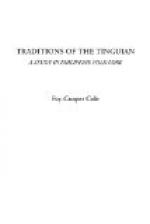As soon as they were married and they had learned who their mothers were they built balaua, and they sent some betel-nuts to invite all of their relatives in other towns. Iwaginan and Indayo went to attend the balaua, and they danced. They saw that those girls were their wives and they tried to take them back home, but Kanag and Dagolayen would not let them. They said it was not good for them to be married even though they wished to be married to them, because the girls would become oil when they went close to them. So Indayo and Iwaginan were very sorry. Ganinawan was the sister of Kanag and Asigtanan was the sister of Dagolayen. They did not find out that they were related until Indayo and Iwaginan took them, for their mothers had lost them in miscarriages, and the girls became women by themselves, and the king found them.
(Told by Talanak of Manabo.)
Ritualistic and Explanatory Myths
32 [303]
The Ipogau [304] are making Sayang. [305] “Why do not those Ipogau who are making Sayang start the balaua [306] correctly?” said the spirits above. Those anitos [307] who are married, who are Kadaklan and Agemem, [308] say, “It is better that you carry the pig.” Then truly they carried the pig up the river, those two Ipogau who are married. “Ala! you walk and walk until you arrive at Sayau, for a person who lives there is making Sayang,” said the spirits. After that they arrived, those who are married who carried the pig, at the place of the man who made Sayang. “Where are you going?” asked the man of Sayau of those who carried the pig. “We came to see how you make Sayang, for we have not yet learned how to make Sayang correctly,” said those who are married. “Ala! watch what I am doing and imitate.” They watched what he did when he made Sayang, and he did everything. He made balag, sagoyab, aligang, they made also tangpap, they made adagang, balabago, and what is needed for al-lot. [309] After that, “You go home, and when you make Sayang you do as I did,” said the man from Sayau. They went home truly, those Ipogau, and they imitated the man who made Sayang in Sayau; then those who are married—Kadaklan and Agemem—caused the spirits to come whom they called, those who made diam when they built balaua. (Here the medium names the spirits which cause sickness.)




